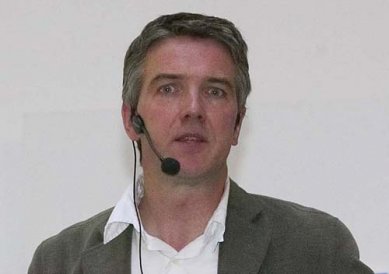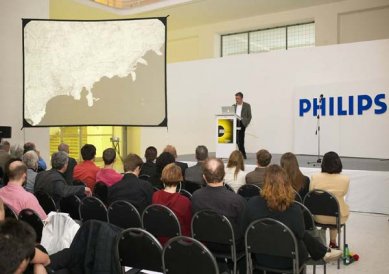
Xaveer de Geyter lectured in the Czech Republic
28.4.2005 18:30 - Trade Fair Palace in Prague
29.4.2005 13:00 - auditorium of the Faculty of Architecture VUT in Brno
On April 28 and 29, two lectures were held by the Belgian architect Xaveer de Geyter. His first lecture was a continuation of the Archiechos lecture cycle organized by Philips and the Center for Architecture. The second lecture took place in Brno and allegedly replaced a regular lecture by a world architect during the IBF construction fair (last year in Brno it was Neutelings, in previous years, for example, Zumthor, Bruder, or Beel). Xaveer de Geyter works in Ghent, Belgium, where the Faculty of Architecture is also located, with which the Brno FA has a partnership. Furthermore, De Geyter admires Mies van der Rohe, so there were more than enough reasons to repeat the lecture in Brno.
Thanks to Philips, the leading figure of the "Vanpoïntzïrou" Generation, Winy Maas from MVRDV, visited Prague in the first act of Archiechos. If Philips wanted to improve the quality of its lectures, it would have to invite at least Rem Koolhaas, under whom de Geyter trained as an architect. However, the bar was set too high, and we had to settle for Rem's student. This designation is appropriate, as de Geyter absorbed the atmosphere of OMA during his 10 years there, and even his current works do not deviate from the "OMAism" stream.
During the lecture, I experienced an endless déjà vu, as I had read the notes from Xaveer de Geyter's lecture at the Berlage Institute on May 20, 2003 (!!!), which Adam Gebrian has in his anthology 29+3. Besides the competition project for the Paris "belly" Les Halles, de Geyter did not show anything more significant than two years earlier in Rotterdam. He began the lecture with an urban project for Brussels, where a new train station is supposed to be built. The ambitious development of the northern part from the city center with tower blocks and the overall concept pointed to training at OMA, respectively in Corbusier's vision of urbanism, whose descent into hell was confirmed by the world in the second half of the 20th century when urbanists attempted to apply it. Urbanism is indeed the biggest weakness of OMA and de Geyter. Besides Brussels, this was also evident in the realization of residential buildings in Breda. The overall urban concept from the OMA monitor based on the "shake it and leave it" concept is generous when viewed from an airplane, but in terms of ground perception, the non-communicating solitaires in the park are truly nothing refreshing. De Geyter's apartment buildings are sexy, as evidenced by their nomination for the Mies van der Rohe Award. They contain a speculative element of a diagonal load-bearing "grid," which serves more of a visual function than a static one. Nonetheless, the living space of the individual apartments is excellent, and the concept of different facades of the residential towers is interesting. From the apartment buildings in Breda, I am starting to feel that our culture is becoming Americanized. The sidewalk is receding into the background, and the access road for cars is gaining importance.
This motif is also present in Corbusier's Villa Savoye, from which de Geyter's villa in Belgium, for which the architect left OMA, draws significantly. The garage structure is placed on the roof, with living space below it. Atriums and patios are carved into the mass of the house, illuminating and ventilating the living environment. In this villa, the influence of Mies and Le Corbusier is clearly manifested.
A very interesting project, at least in terms of its assignment, represents the expansion of the Principality of Monaco. Monaco is essentially a family business that attracts the wealthy through tax policies, and since the wealthy need space, Monaco must develop and expand. In the case of one of the smallest countries in the world, this seems like a problem, but such extreme assignments stimulate architects' thinking and bring interesting solutions - e.g., the Berlin Wall, Dutch polders, or Hong Kong. I like these anomalies because they can provide solutions that would be hard to find under normal circumstances and probably never have existed. De Geyter offered four approaches to development - a peninsula, two peninsulas, an island, and trash in the sea. I was very curious about this project, and it did not disappoint me. If only there were more such assignments and clients!
De Geyter also presented other projects that, in retrospect, did not remain in my memory, but they were not groundbreaking. Perhaps except for the Parisian Les Halles, which OMA probably designed more (according to predecessors with sloping facades that de Geyter does not have up his sleeve). I was a little disappointed that while Xaveer de Geyter boasted that he is currently constructing 8 or 12 buildings, he did not present any of them. The lecture contained a little essence from OMA, but he was by no means Rem. However, we should thank Philips for every drop of world architecture that quenches our thirst. Let’s be surprised by whom Philips serves us next. If Philips follows the sinusoidal pattern known in electrical engineering, we have a chance to look forward to an excellent lecture. In my opinion, de Geyter underestimated the lecture. Thanks to Adam, we know this and can feel a bit like the barbaric east, for which a special lecture does not need to be prepared. Perhaps Philips got a discount for repeating. I understand that music bands tour several cities with one program, but a two-year interval would already require the release of a "new album." In any case, thanks to Philips for the experience and the subsequent reception.
About Royal Philips Electronics
Royal Philips Electronics, Netherlands (NYSE: PHG, AEX: PHI) is one of the largest electronic companies in the world and the largest electronic company in Europe with a turnover of 30.3 billion EUR in 2004. With activities in three interrelated areas - healthcare, lifestyle, and technology, and with 161,500 employees in more than 60 countries worldwide, Philips occupies a world-leading position in medical systems for diagnostic imaging and patient monitoring, color televisions, electric shaving devices, lighting, and semiconductor solutions development. Information about Philips is available at www.philips.com/newscenter.
Thanks to Philips, the leading figure of the "Vanpoïntzïrou" Generation, Winy Maas from MVRDV, visited Prague in the first act of Archiechos. If Philips wanted to improve the quality of its lectures, it would have to invite at least Rem Koolhaas, under whom de Geyter trained as an architect. However, the bar was set too high, and we had to settle for Rem's student. This designation is appropriate, as de Geyter absorbed the atmosphere of OMA during his 10 years there, and even his current works do not deviate from the "OMAism" stream.
During the lecture, I experienced an endless déjà vu, as I had read the notes from Xaveer de Geyter's lecture at the Berlage Institute on May 20, 2003 (!!!), which Adam Gebrian has in his anthology 29+3. Besides the competition project for the Paris "belly" Les Halles, de Geyter did not show anything more significant than two years earlier in Rotterdam. He began the lecture with an urban project for Brussels, where a new train station is supposed to be built. The ambitious development of the northern part from the city center with tower blocks and the overall concept pointed to training at OMA, respectively in Corbusier's vision of urbanism, whose descent into hell was confirmed by the world in the second half of the 20th century when urbanists attempted to apply it. Urbanism is indeed the biggest weakness of OMA and de Geyter. Besides Brussels, this was also evident in the realization of residential buildings in Breda. The overall urban concept from the OMA monitor based on the "shake it and leave it" concept is generous when viewed from an airplane, but in terms of ground perception, the non-communicating solitaires in the park are truly nothing refreshing. De Geyter's apartment buildings are sexy, as evidenced by their nomination for the Mies van der Rohe Award. They contain a speculative element of a diagonal load-bearing "grid," which serves more of a visual function than a static one. Nonetheless, the living space of the individual apartments is excellent, and the concept of different facades of the residential towers is interesting. From the apartment buildings in Breda, I am starting to feel that our culture is becoming Americanized. The sidewalk is receding into the background, and the access road for cars is gaining importance.
This motif is also present in Corbusier's Villa Savoye, from which de Geyter's villa in Belgium, for which the architect left OMA, draws significantly. The garage structure is placed on the roof, with living space below it. Atriums and patios are carved into the mass of the house, illuminating and ventilating the living environment. In this villa, the influence of Mies and Le Corbusier is clearly manifested.
A very interesting project, at least in terms of its assignment, represents the expansion of the Principality of Monaco. Monaco is essentially a family business that attracts the wealthy through tax policies, and since the wealthy need space, Monaco must develop and expand. In the case of one of the smallest countries in the world, this seems like a problem, but such extreme assignments stimulate architects' thinking and bring interesting solutions - e.g., the Berlin Wall, Dutch polders, or Hong Kong. I like these anomalies because they can provide solutions that would be hard to find under normal circumstances and probably never have existed. De Geyter offered four approaches to development - a peninsula, two peninsulas, an island, and trash in the sea. I was very curious about this project, and it did not disappoint me. If only there were more such assignments and clients!
De Geyter also presented other projects that, in retrospect, did not remain in my memory, but they were not groundbreaking. Perhaps except for the Parisian Les Halles, which OMA probably designed more (according to predecessors with sloping facades that de Geyter does not have up his sleeve). I was a little disappointed that while Xaveer de Geyter boasted that he is currently constructing 8 or 12 buildings, he did not present any of them. The lecture contained a little essence from OMA, but he was by no means Rem. However, we should thank Philips for every drop of world architecture that quenches our thirst. Let’s be surprised by whom Philips serves us next. If Philips follows the sinusoidal pattern known in electrical engineering, we have a chance to look forward to an excellent lecture. In my opinion, de Geyter underestimated the lecture. Thanks to Adam, we know this and can feel a bit like the barbaric east, for which a special lecture does not need to be prepared. Perhaps Philips got a discount for repeating. I understand that music bands tour several cities with one program, but a two-year interval would already require the release of a "new album." In any case, thanks to Philips for the experience and the subsequent reception.
Jan Kratochvíl
> www.xdga.beAbout Royal Philips Electronics
Royal Philips Electronics, Netherlands (NYSE: PHG, AEX: PHI) is one of the largest electronic companies in the world and the largest electronic company in Europe with a turnover of 30.3 billion EUR in 2004. With activities in three interrelated areas - healthcare, lifestyle, and technology, and with 161,500 employees in more than 60 countries worldwide, Philips occupies a world-leading position in medical systems for diagnostic imaging and patient monitoring, color televisions, electric shaving devices, lighting, and semiconductor solutions development. Information about Philips is available at www.philips.com/newscenter.
The English translation is powered by AI tool. Switch to Czech to view the original text source.





0 comments
add comment










